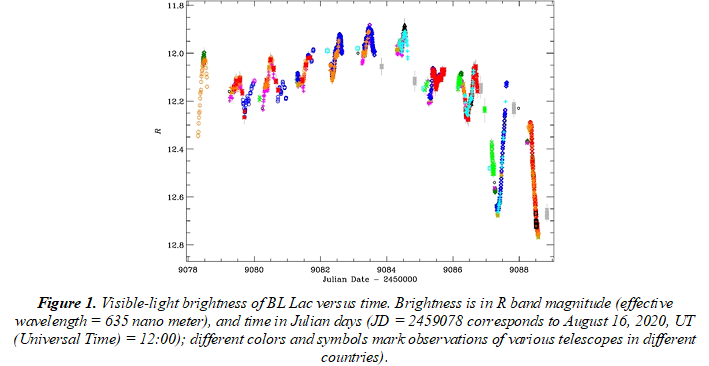Scientists have spotted surprising rapid oscillations of brightness in the jet of a blazar called BL Lac during a strong multi-wavelength outburst in the second half of 2020, which was rich in gamma rays. They have attributed these cycles of brightness changes termed quasi-periodic oscillations (QPOs) to twists in the magnetic field in the jet.
BL Lac is a type of active galactic nucleus (AGN) or a galaxy with such an AGN, named after its prototype, BL Lacertae. In contrast to other types of active galactic nuclei, BL Lacs are characterized by rapid and large-amplitude flux variability and significant optical polarization. Like all blazars, it is powered by material falling into a supermassive black hole (SMBH) at the center of a galaxy. About 10% of AGNs have a pair of jets that are propelled into interstellar space at near-light speeds. Blazars occur when one of the jets points almost directly toward Earth, making it appear much brighter. The jets produce light from radio to visible to X-rays and gamma-rays, which changes rapidly with time. Those changes are usually random, with no discernible pattern.
To trace these, observations with the Whole Earth Blazar Telescope (WEBT) were organized by Drs. Claudia M. Raiteri and Massimo Villata of INAF-Osservatorio Astrofisico di Torino, Italy, to monitor variability of visible light in blazars that are bright in gamma-rays.

A team of 86 scientists from 13 countries, including Dr. Alok Chandra Gupta from Aryabhatta Research Institute of Observational Sciences (ARIES), Nainital, an autonomous institution of the Department of Science and Technology (DST), Government of India, carried out an extensive high time resolution optical monitoring of the blazar BL Lacertae (BL Lac) during March – December 2020.
Optical observations by the WEBT collaboration of astronomers, working together with 37 ground-based telescopes around the globe, found cycles of visible brightness changes as fast as about 13 hr in a jet of high-energy particles of BL Lac —a blazar powered by a black hole located roughly 1 billion light years away.
The group included scientists from 46 institutions in India, USA, Russia, Italy, Spain, Taiwan, Georgia, Germany, Japan, Bulgaria, Serbia, Denmark and Uzbekistan, and the telescopes included the 1.04m and 1.3m at ARIES.
“The cycles of brightness changes termed quasi-periodic oscillations (QPOs) are more often seen in other systems called X-ray black hole binaries, which have black holes with smaller masses of 10 - 50 M and are generally explained by clumps of hot gas in the disk of accreting material orbiting the black hole,” said Dr. Svetlana Jorstad of Boston University, who led the team of astronomers participating in the study published in the Nature.

“However, in the case of BL Lac, the light is polarized, which is not the case for emission by hot gas in the disk, so interpreting such behavior is difficult,” she indicates.
The team has proposed that a kink forms in the jet, twisting the magnetic field in such a way that it causes the brightness to oscillate. Furthermore, the polarization changes with a similar timescale as the brightness. “Such polarized light comes from the jet, and the polarization can vary only if the magnetic field changes in the light-producing region. The magnetic field in the jet must be twisting in order to cause the oscillations,’’ explains Prof. Alan Marscher of Boston University, an expert in blazar research and a co-author in the study.
The study can help trace the origin of gamma rays in AGNs. “The observations of BL Lac show a strong correlation between visible light and gamma ray variations without any delay, which places gamma-rays in the region where the visible light changes,” says Jorstad.
Publication link: DOI: https://www.nature.com/articles/s41586-022-05038-9
For more details, Dr. Alok Chandra Gupta (Scientist – F) (+91-7895966668, alok[at]aries[dot]res[dot]in) can be contacted.






























